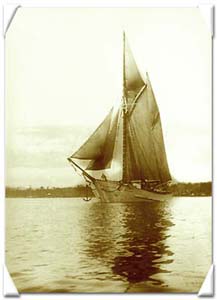
Developing trade and port histories: Mosquito fleet
Introduction
 South Australia's mosquito fleet of small coasting ships played a significant role in the state's development, trading with the remote communities along the coast, daring to beach in isolated bays in pursuit of the small cargoes the larger ships ignored. They also served as lighters to the overseas ships, carrying cargo from smaller ports and trans-shipping from wharfs and jetties to ships moored in deep water. As the years passed they competed with the steamers because they were cheaper to operate, but eventually the times and the age of the little ships told against them. Customers wanted assurance of pick up and delivery to a schedule. The last of South Australia's mosquito fleet were withdrawn from service in 1982.
South Australia's mosquito fleet of small coasting ships played a significant role in the state's development, trading with the remote communities along the coast, daring to beach in isolated bays in pursuit of the small cargoes the larger ships ignored. They also served as lighters to the overseas ships, carrying cargo from smaller ports and trans-shipping from wharfs and jetties to ships moored in deep water. As the years passed they competed with the steamers because they were cheaper to operate, but eventually the times and the age of the little ships told against them. Customers wanted assurance of pick up and delivery to a schedule. The last of South Australia's mosquito fleet were withdrawn from service in 1982.
The mosquito fleet consisted of cutters, ketches, schooners and brigantines. They carried any cargo to wherever was required, within reason. They were economical, particularly with 'low-value bulk cargoes, such as stone for bridges, roads and railways' (Parsons, page 175). With low running costs, and often minimal manning, the ketch trade operated long past the advent of road and rail transport, and the introduction of coastal steamships. Expert seamanship was needed as was hard muscle to load and unload the vessels.
The Casuarina was the first small vessel to operate in South Australian waters, but as an exploring vessel not a trader. It was part of the French expedition of Nicolas Baudin and surveyed the South Australian gulfs. The following year, 1803, the vessel Independence, 30 tons, was built on Kangaroo Island by the crew of the American ship Union. It appeared in Sydney in June 1805, but beyond that nothing is known of the vessel.
First coastal traders
When the first settlers arrived in South Australia in 1836, a cutter was chartered by the South Australian Company from Tasmania. The William was about 30 tons and remained with the Company until it was wrecked in Yankalilla Bay in August 1838. The Mary Ann and Waterwitch were also employed by the South Australian Company in the late 1830s. Over the next three years the fleet of small ships grew by three or four a year, and began the history of service to the outlying communities. At a period when roads were barely tracks, or were totally non-existent, the mosquito fleet carried not only cargo and provisions, but people. They carried the stone for building roads and wharfs, the timber for jetties; they carried the grain from the first harvests along the Fleurieu Peninsula, and they travelled to Victoria and Tasmania to bring back vital supplies for the growing colony.
In size they ranged from 30-100 tons, although the tiny Petrel of 13 tons, and with a crew of two, carried passengers to Melbourne. As jetties were built and ports developed along the coast the ketches proliferated. Despite the large ocean-going ships delivering and collecting cargo from the main ports in the gulfs, the ketch fleet served the far west coast and the south-east of the state where these ships did not venture. Life was hard in these small craft and these distant coasts were exposed to the weather: many ketches and cutters left port never to be heard of again-swamped by large seas, or wrecked on a deserted shore. As the 20th century advanced, in an endeavour to keep pace with the coastal steamers, many ketch captains installed auxiliary engines. Time was more pressing in the new age and merchants wanted schedules that were adhered to. A number of the ketches were called to service during World War II, carrying supplies and ammunition in northern Australia and the South West Pacific.













